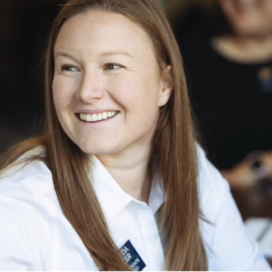Pulling a business up by its bootstraps
Published: February 5, 2007 / Author: Carol Newswriting
Jim Larkin advises would-be entrepreneurs to “thumb your nose at the venture capitalists,” when creating their business plans. It’s an unconventional piece of advice, but right to the point of bootstrap financing, which is a means of building a business with little or no outside capital.
Larkin, president of Scientific Methods in Granger, Ind., presented “Bootstrapping Your New Venture” to a group of about 30 students, alumni and community members on Jan. 24, 2007, as part of a series of training sessions hosted by the Gigot Center for Entrepreneurial Studies. The nine sessions, funded by a $100,000 endowment awarded by the Nasdaq Educational Foundation, provide opportunities for students and alumni competing in the annual McCloskey Business Plan and the Social Venture Plan competitions to hear practical marketing advice from members of entrepreneurial support group IrishAngels.
Topics of the sessions include defining the customer base, creating financial statements and learning how to avoid presentation pitfalls. The speakers provide opportunities for the entrepreneurs to network and find mentors. They also give first-person accounts of the travails and rewards of starting a new business—complementary material to the classroom instruction.
“We want to give students that marketplace perspective that is key to everything they are learning,” said Theresa Sedlack, venturing programs manager at Gigot.
Larkin brings a depth of experience to the sessions. He utilized bootstrap financing to get two ventures off the ground, including South Bend-based Environmental Health Laboratories, a water-testing business that he sold to product safety testing and certification giant Underwriters Laboratories in 2001.
Larkin says the conventional business plan involves three steps: coming up with a great business idea, raising $500,000 to $1 million in outside capital, and finally, serving the customer. Bootstrap plans have two steps; they move from the great idea to serving the customer without raising a large sum of capital before the venture is launched. Here, the owners raise money or secure assets as needs arise, and carefully evaluate which outlays are truly necessary. For example, entrepreneurs often spend thousands in attorney fees to incorporate, and they may invest hundreds of thousands of dollars in a sophisticated Web site. Larkin suggests the owners can incorporate themselves with a visit to the state’s Secretary of State Office, and they can function with a basic site until they actually have products or services to sell.
The initial capital raised in a bootstrap plan is usually $30,000 to $50,000, much less than with a conventional plan. It typically comes from the pockets of “family, friends and fools,” says Larkin, instead of lending institution or venture funds.
Another key bootstrapping concept is the idea of “seeking revenue, not funding.” This involves bartering for needed resources instead of buying them outright. Larking refers to this as trading in the “coin of the realm.” An entrepreneur might barter painting services for office space, or company stock for supplies. “Look for partnerships,” says Larkin. “Don’t assume you need capital.”
Bootstrapping is a hard, long road and doesn’t work for every venture, says Larkin, adding that it takes about 30 months—or more—before the first paycheck from operations arrives. But the method of financing also means an entrepreneur can hang onto a higher percentage of ownership, which later translates into greater wealth than conventional financing if the venture is successful.
“Bootstrapping is the more difficult path, but the more probable path for ending up a fairly wealthy person,” says Larkin.
###
/news_and_events/news_articles/article/950/pulling-a-business-up-by-its-bootstraps




